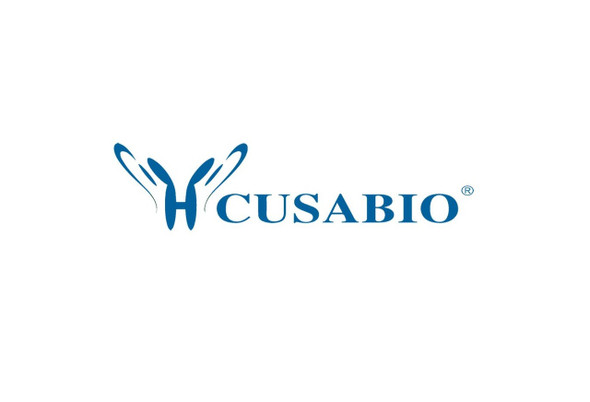Cusabio Human Recombinants
Recombinant Human Ubiquitin-like protein ISG15 (Isg15) | CSB-EP011843HU
- SKU:
- CSB-EP011843HU
- Availability:
- 3 - 7 Working Days
Description
Recombinant Human Ubiquitin-like protein ISG15 (Isg15) | CSB-EP011843HU | Cusabio
Alternative Name(s): Interferon-induced 15KDA proteinInterferon-induced 17KDA protein ;IP17Ubiquitin cross-reactive protein
Gene Names: Isg15
Research Areas: Immunology
Organism: Homo sapiens (Human)
AA Sequence: GWDLTVKMLAGNEFQVSLSSSMSVSELKAQITQKIGVHAFQQRLAVHPSGVALQDRVPLASQGLGPGSTVLLVVDKCDEPLSILVRNNKGRSSTYEVRLTQTVAHLKQQVSGLEGVQDDLFWLTFEGKPLEDQLPLGEYGLKPLSTVFMNLRLRGG
Source: E.coli
Tag Info: N-terminal GST-tagged
Expression Region: 2-157aa
Sequence Info: Full Length of Mature Protein
MW: 44.3 kDa
Purity: Greater than 90% as determined by SDS-PAGE.
Relevance: Ubiquitin-like protein which plays a key role in the innate immune response to viral infection either via its conjugation to a target protein (ISGylation) or via its action as a free or unconjugated protein. ISGylation involves a cascade of enzymatic reactions involving E1, E2, and E3 enzymes which catalyze the conjugation of ISG15 to a lysine residue in the target protein. Its target proteins include SERPINA3G/SPI2A, JAK1, MAPK3/ERK1, PLCG1, TRIM25, STAT5A, MAPK1/ERK2 and globin. Can also isgylate: DDX58/RIG-I which inhibits its function in antiviral signaling response and EIF4E2 which enhances its cap structure-binding activity and translation-inhibition activity. Exhibits antiviral activity towards both DNA and RNA viruses, including influenza A and B virus, sindbis virus (SV) and herpes simplex type-1 (HHV-1). Plays a significant role in the control of neonatal Chikungunya virus (CHIKV) infection by acting as a putative immunomodulator of proinflammatory cytokines. Protects mice against the consequences of Chikungunya virus infection by downregulating the pathogenic cytokine response, often denoted as the cytokine storm. Plays a role in erythroid differentiation. The secreted form of ISG15 can: induce natural killer cell proliferation, act as a chotactic factor for neutrophils and act as a IFN-gamma-inducing cytokine playing an essential role in antimycobacterial immunity
Reference: Identification of a ubiquitin family protein as a novel neutrophil chemotactic factor.Owhashi M., Taoka Y., Ishii K., Nakazawa S., Uemura H., Kambara H.Biochem. Biophys. Res. Commun. 309:533-539(2003)
Storage: The shelf life is related to many factors, storage state, buffer ingredients, storage temperature and the stability of the protein itself. Generally, the shelf life of liquid form is 6 months at -20?/-80?. The shelf life of lyophilized form is 12 months at -20?/-80?.
Notes: Repeated freezing and thawing is not recommended. Store working aliquots at 4? for up to one week.
Function: Ubiquitin-like protein which plays a key role in the innate immune response to viral infection either via its conjugation to a target protein (ISGylation) or via its action as a free or unconjugated protein. ISGylation involves a cascade of enzymatic reactions involving E1, E2, and E3 enzymes which catalyze the conjugation of ISG15 to a lysine residue in the target protein. Its target proteins include IFIT1, MX1/MxA, PPM1B, UBE2L6, UBA7, CHMP5, CHMP2A, CHMP4B and CHMP6. Can also isgylate
Involvement in disease: Immunodeficiency 38, with basal ganglia calcification (IMD38)
Subcellular Location: Cytoplasm, Secreted
Protein Families:
Tissue Specificity: Detected in lymphoid cells, striated and smooth muscle, several epithelia and neurons. Expressed in neutrophils, monocytes and lymphocytes. Enhanced expression seen in pancreatic adenocarcinoma, endometrial cancer, and bladder cancer, as compared to non-cancerous tissue. In bladder cancer, the increase in expression exhibits a striking positive correlation with more advanced stages of the disease.
Paythway:
Form: Liquid or Lyophilized powder
Buffer: If the delivery form is liquid, the default storage buffer is Tris/PBS-based buffer, 5%-50% glycerol. If the delivery form is lyophilized powder, the buffer before lyophilization is Tris/PBS-based buffer, 6% Trehalose, pH 8.0.
Reconstitution: We recommend that this vial be briefly centrifuged prior to opening to bring the contents to the bottom. Please reconstitute protein in deionized sterile water to a concentration of 0.1-1.0 mg/mL.We recommend to add 5-50% of glycerol (final concentration) and aliquot for long-term storage at -20?/-80?. Our default final concentration of glycerol is 50%. Customers could use it as reference.
Uniprot ID: P05161
HGNC Database Link: HGNC
UniGene Database Link: UniGene
KEGG Database Link: KEGG
STRING Database Link: STRING
OMIM Database Link: OMIM









